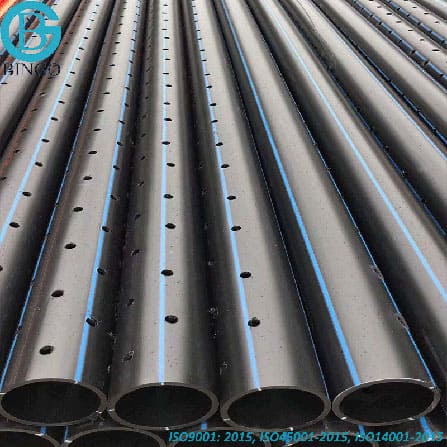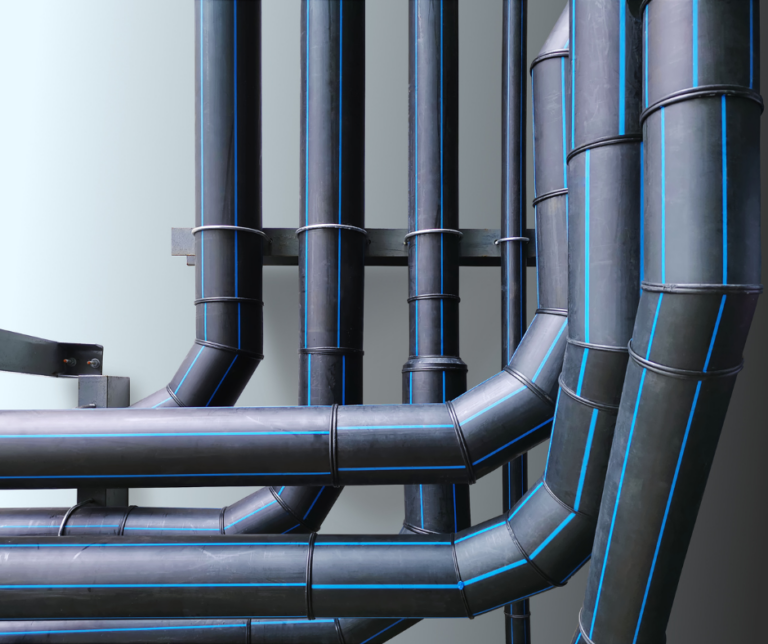hdpe pipe suppliers Midland TX: Selection Guide for Contractors
Wiki Article
Explore the Production Refine Behind High-Quality HDPE Pipe and Its Applications
The production procedure of high-grade HDPE pipelines is detailed and systematic. It starts with the option of resources that enhance efficiency. Following this, ethylene undertakes polymerization to develop material, which is after that shaped with extrusion. Quality control is paramount, making certain that the final item fulfills rigorous criteria. Nonetheless, the trip of HDPE pipes does not finish with manufacturing. Their applications across various industries disclose a wider relevance worth examining.Comprehending HDPE: Properties and Advantages

High-density polyethylene (HDPE) is a flexible thermoplastic understood for its sturdiness and resistance to different environmental aspects. This material displays exceptional tensile toughness, making it suitable for requiring applications. Its low-density framework adds to a light-weight item, promoting ease of dealing with and installation. HDPE also showcases amazing resistance to chemicals, which reduces degradation when exposed to harsh materials.
The product's reduced dampness absorption further boosts its longevity, making it perfect for use in pipelines and storage space tanks. Additionally, HDPE is immune to ultraviolet (UV) radiation, making sure that products maintain their stability also when subjected to sunshine. Its flexibility allows for the production of elaborate forms without endangering toughness. The green nature of HDPE, often obtained from recycled materials, contributes to its charm, promoting lasting methods in production. Overall, these residential properties and advantages make HDPE a favored option for numerous industrial and consumer applications.
Resources Selection for HDPE Manufacturing
The selection of raw materials for HDPE production is necessary to verify the end product satisfies the desired specs and top quality requirements. High-density polyethylene (HDPE) is mainly created from polymerized ethylene, obtained from nonrenewable fuel sources such as natural gas or crude oil. The quality of these feedstocks considerably influences the mechanical and thermal properties of the final HDPE.Additives additionally play a substantial function in improving HDPE's performance, including anti-oxidants, UV stabilizers, and colorants, which improve resilience and resistance to ecological factors. The selection procedure have to consider not only the chemical make-up of the raw materials however likewise their handling qualities to assure effective manufacturing.
Moreover, the sourcing of raw products need to prioritize sustainability and conformity with environmental regulations, as liable techniques are necessary in today's market. Ultimately, cautious raw product choice lays the foundation for producing high-grade HDPE pipelines suitable for varied applications.
The Extrusion Refine: Forming HDPE Pipeline
The extrusion process plays a vital function in shaping HDPE pipes, starting with meticulous material preparation techniques that ensure perfect circulation and consistency. Equally crucial is the layout of the die, which straight affects the final dimensions and surface high quality of the pipe. Together, these variables contribute substantially to the performance and quality of HDPE pipeline production.Product Prep Work Strategies
Efficient production of HDPE pipes starts with meticulous material preparation techniques, especially the extrusion procedure. Throughout this phase, high-density polyethylene resin is very first dried to eliminate moisture, making certain suitable circulation attributes. The material is then fed into the extruder, where it goes through heating and melting, changing right into a viscous state. This home heating process is thoroughly managed to maintain the material's stability and performance. The molten HDPE is forced via a die, shaping it into a constant pipe form. Correct temperature management throughout extrusion is vital, as it straight influences the product's properties and the end product top quality. As soon as formed, the HDPE pipe is cooled and cut to specified sizes, all set for succeeding processing and applications.Die Style Value
Accuracy in die layout plays a necessary function in the extrusion process of HDPE pipelines. The die functions as the last shaping tool, straight influencing the pipe's dimensions, wall surface thickness, and surface finish. A properly designed die guarantees consistent material circulation, lowering flaws such as irregularities and weak points. The geometry of the die must be optimized to fit the particular properties of HDPE, including its viscosity and thermal behavior during extrusion. Additionally, the cooling price of the material as it passes via the die can significantly impact the pipeline's structural honesty. Investing in sophisticated die technology is essential for manufacturers aiming to generate high-grade HDPE pipelines that fulfill industry standards and consumer expectations.Quality Assurance Procedures in HDPE Production
Numerous factors affect the top quality of HDPE pipeline production, efficient high quality control steps are vital to assure uniformity and dependability in the final product (Pipe Manufacturing Midland TX). Key top quality control techniques consist of rigorous product inspection, confirming that the raw polyethylene meets well established standards for purity and density. During the extrusion process, criteria such as temperature, pressure, and cooling time are very closely kept track of to keep dimensional precision and structural integrityIn enhancement, post-production screening is vital; producers commonly perform hydrostatic examinations to evaluate the pipe's toughness and resistance to pressure. Aesthetic inspections for surface issues even more boost quality guarantee. Qualification from appropriate standards companies, like ASTM or ISO, offers an additional layer of reputation. By implementing these complete quality assurance procedures, manufacturers can lessen defects, improve efficiency, and guarantee that the HDPE pipelines meet the certain demands of numerous applications, ultimately bring about customer complete satisfaction and count on the product.
Applications of HDPE Pipeline Across Industries
HDPE pipelines are made use of across different markets because of their sturdiness and versatility. In water distribution systems, they ensure effective delivery, while in wastewater administration, they supply reliable services for waste transport. Additionally, agricultural watering networks benefit from HDPE's resistance to deterioration and flexibility, making it a suitable selection for modern-day farming practices.
Water Distribution Equipments
A significant number of markets count on high-density polyethylene (HDPE) pipelines for reliable water circulation systems. Understood for their resilience and resistance to rust, HDPE pipelines are commonly utilized in metropolitan supply of water networks, agricultural watering, and commercial applications. Their light-weight nature facilitates simple handling and installment, reducing labor prices and time. In addition, HDPE pipes can fit various stress degrees, making them appropriate for both reduced and high-pressure systems. hdpe pipe in stock Midland TX. The flexibility of the material permits seamless assimilation into existing facilities, reducing the requirement for considerable excavation. Moreover, HDPE's resistance to chemical leaching guarantees that the water provided remains risk-free and tidy, making it a suitable option for maintaining the high quality of safe and clean water across different industriesWastewater Management Solutions
Efficient water distribution systems additionally lead the way for innovative wastewater management options, where high-density polyethylene (HDPE) pipes play a significant role. Popular for their longevity and resistance to corrosion, HDPE pipes are perfect for carrying wastewater in numerous setups. Their flexibility enables very easy setup in complex atmospheres, reducing the requirement for extensive excavation. In addition, HDPE's smooth indoor surface decreases friction, boosting circulation rates and effectiveness. These pipelines are likewise immune to chemical leaching, ensuring that contaminants do not compromise the surrounding environment. Industries, towns, and treatment facilities progressively depend on HDPE pipes for their reliability and long life, making them a preferred option for contemporary wastewater monitoring systems. This flexibility highlights the vital value of HDPE pipelines throughout many applications.Agricultural Watering Networks
Agricultural irrigation networks benefit significantly from the usage of high-density polyethylene (HDPE) pipelines, which supply efficient and reliable water distribution to plants. HDPE pipes are lightweight, making them very easy to carry and install, while their flexibility enables various arrangements in varied terrains. These pipelines demonstrate outstanding resistance to deterioration, chemicals, and UV radiation, guaranteeing toughness in rough agricultural settings. In addition, their smooth interior surface decreases friction loss, maximizing water flow and reducing energy costs linked with pumping. The durability of HDPE pipelines, frequently going beyond 50 years, adds to decrease maintenance and replacement expenses. Farmers progressively depend on HDPE pipelines to improve irrigation efficiency and advertise sustainable farming practices, inevitably leading to improved crop returns and resource preservation.
Future Patterns in HDPE Pipeline Innovation
As the need for sustainable and effective framework expands, advancements in HDPE pipeline technology are positioned to transform numerous sectors. Arising patterns consist of the integration of smart innovations, such as sensing units and IoT capacities, which promote real-time monitoring of pipe problems, decreasing upkeep expenses and preventing leakages. In addition, the growth of advanced production strategies, such as 3D printing, is making it possible for the production of facility, customized pipe layouts that cater to specific task needs.Moreover, the concentrate on recycling and circular economic climate methods is driving the development of HDPE pipelines made from recycled materials, improving sustainability. Boosted jointing methods, such as electro-fusion and mechanical fittings, here are likewise enhancing installation performance and dependability. Ultimately, the growing emphasis on ecological regulations is pushing manufacturers to take on greener manufacturing procedures, ensuring that HDPE pipes not just meet market criteria yet also promote an even more lasting future for infrastructure advancement.
Often Asked Concerns
How Does HDPE Compare to Various Other Plastic Products?
HDPE outshines several other plastic products regarding durability, chemical resistance, and adaptability. Its low density and high tensile strength make it ideal for numerous applications, commonly surpassing alternatives in both efficiency and longevity.What Are the Ecological Impacts of HDPE Production?
The environmental influences of HDPE manufacturing consist of greenhouse gas discharges, energy intake, and possible contamination from manufacturing processes. Furthermore, incorrect disposal can result in dirt and water contamination, raising worries concerning lasting environmental impacts.Can HDPE Water Lines Be Recycled?
Yes, HDPE pipelines can be recycled. Several centers approve utilized HDPE for processing, transforming it into new products. This recycling adds to sustainability efforts, minimizing plastic waste while conserving sources and power in the manufacturing cycle.What Is the Lifespan of HDPE Piping?

How Do Temperature Variations Influence HDPE Pipeline Efficiency?
Temperature variants significantly affect HDPE pipe efficiency, impacting versatility and toughness. High temperatures can bring about softening, while reduced temperatures might cause brittleness, ultimately influencing the pipe's sturdiness and viability for different applications in varied atmospheres.Report this wiki page